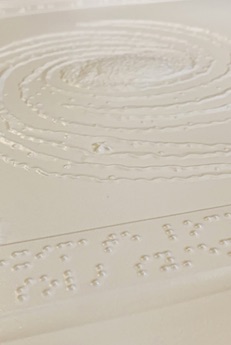 By Jay M. Pasachoff
By Jay M. Pasachoff
The fifth edition of this tactile book, with raised outlines for the illustrations and with both Braille and visible text, is a wonder to behold. It is much enlarged since the first edition from 2002 I reviewed for ΦBK in 2005-06. On the illustrations, designed by Irma Goldberg and Shirley Keller, you can use your finger to trace out the shape of the solar corona at an eclipse, or of the rings of Saturn, or of the spiral arms of a galaxy. I am glad that in this edition, with my ability to read English but not Braille, I could read and verify the picture captions and descriptive text. I found both to be accurate, with but the common quibble that Noreen Grice did not distinguish between the dangerous part of eclipse observations (the partial phases) and the safe part (totality).
The foreword is by D. Kent Cullers, who starts “I am the world’s first totally blind astronomer,” and was blind from birth. Still, radio astronomy and his work with SETI, the Search for Extraterrestrial Intelligence, have been productive outlets for him.
Among my other favorite tactile illustrations are the Big Dipper, with the stars not only linked to show the asterism but also surrounded by the shape of the Big Bear; the phases of the Moon; Jupiter with its Great Red [without color being shown] spot; and the concentration of stars at the center of a globular cluster. The historical pages include not only Copernicus, Kepler, Tycho, Galileo, and Newton, but also Annie Jump Cannon (who herself was deaf, a suitable counterpart for a book on the visually impaired) for her classification of stars.
Among the most modern illustrations (all labelled in Braille, of course) are the Hubble Deep Field of galaxies and NASA’s Curiosity spacecraft that is now roaming around on Mars.
The status of Pluto has been updated to show it as a dwarf planet only “one-fifth the size of Earth,” meaning diameter, and not the 1/500th the mass of Earth that is also true and that led to Pluto’s promotion by the International Astronomical Union in 2006 (I was there and voted) to be one of the first and best of the then new “dwarf planet” category instead of in the traditional “planet” category that recent research showed it didn’t belong.
The new Unified English Braille System, adopted in 2013, is now used throughout, “canceling” (American) or “cancelling” (British) the prior minor differences among Braille systems.
I recommend this book for anyone who interacts or who might in the future interact with vision impaired children or adults, as well as for anyone who wants to see and feel the tactile illustrations. Sighted and non-sighted people can read this wonderful book together. You can order it (or contribute) at https://www.nbp.org/ic/nbp/TOUCH.html.
Astronomer and author Jay M. Pasachoff is the director of the Hopkins Observatory and Field Memorial Professor of Astronomy at Williams College. He is a Visitor in the Carnegie Observatories. Williams College is home to the Gamma of Massachusetts Chapter of Phi Beta Kappa.




